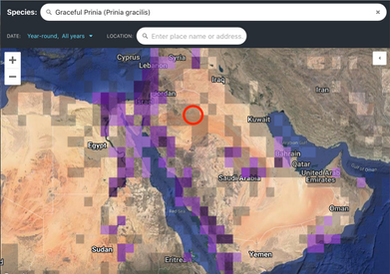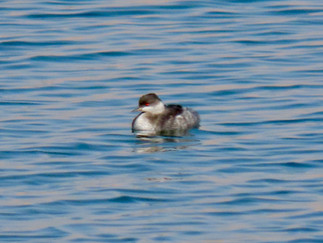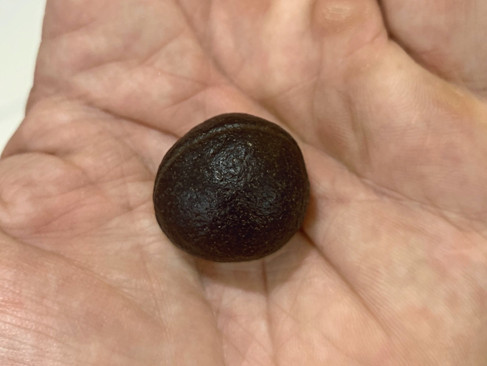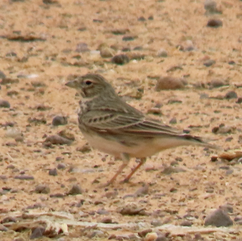Birding the Al Jouf Region
- saudibirding

- Nov 23, 2021
- 10 min read
A recent long weekend at work gave my wife and I the opportunity we needed to finally visit Al Jouf, the northernmost region in Saudi Arabia. Two days is simply not enough time to get up there and give the area a good "shoof", especially as there are no direct flights from Dammam and a long five-hour transfer in Riyadh. Ultimately, we found that driving the 3.5 hours to Riyadh and then flying north was not only faster but also $300 USD cheaper.

Our host for the weekend was Nader Fahad Al Shammari, a teacher and passionate bird photographer from Sakaka, the capital of Al Jouf, which is situated just north of the Al Nafud Desert and to the southeast of the Harrat Al Harrah Conservation Reserve. Nader insisted on giving us a personalized tour of the great birding on offer around Sakaka during our three-day visit, and we're so glad he did. We had a wonderful time exploring the area's wetlands, mountains, farms, and desert with him and seeing some really excellent birds.
The prime targets for the weekend in order of priority were See-See Partridge and Common Wood-Pigeon, which, in Saudi, can only be found in Al Jouf; Mediterranean Short-toed Lark (Alaudala rufescens); and Thick-billed Lark, a bird of stony deserts that has proven most reliable in this region.
As we were arriving quite late on Thursday night, we decided for a slightly later start in the morning and to visit the nearby Sakaka wastewater lake, where, back in June of this year, Nader discovered a White-throated Swallow, a first record not just for the Western Palearctic but for the entire Northern Hemisphere. The furthest north the species had been seen prior was in Tanzania!
Slim chance of seeing the swallow again, but I was interested, however, in finding out what, if any, prinias occurred at the spot. There were no reports in eBird of either Graceful Prinia (P. gracilis) or Delicate Prinia (P. lepida) for the area, and Nader reported never encountering prinias anywhere around Sakaka before. I found this odd given the abundance of farms and small wetlands, but considering Sakaka is over 250 kilometers north, across the vast sand desert of the Great Nafud, from the nearest Graceful Prinias in Ha'il, over 400 kilometers east of the nearest in Tabuk, and over 450 kilometers southwest of the nearest Delicate Prinias in Iraq, perhaps it's no big surprise—much too great a distance to cover, from virtually every direction, for such small, weak flyers as prinias.
Friday, November 12, 2021
We accessed the wastewater lake over a stretch of dunes to the south even though I had seen an access road to the north in Google Maps. When I questioned Nader about this, he explained that the municipality had barricaded the entrance road at its start to prevent people from entering and that it'd been decided to redirect the flow of treated wastewater further away from the city as a mosquito mitigation measure and let this erstwhile birding hotspot go dry. Thankfully there was still plenty of water in the lake to attract a nice mix of waterbirds I don't often see at Al Asfar Lake in Al Ahsa, such as an abundance of Eurasian Coot and Ferruginous Duck. While scanning the open water from a small dune rising up beside the edge of the reedbeds, I saw a tight raft of about 30 large white birds move into view to the north of our position. I called out to Nader, "pelicans!" Great White Pelicans, in fact, and my first for Saudi. Not a bad start to the trip as they didn't even cross my mind as a possibility. They're normally found wintering along the Red Sea coast south of Jeddah or further still in East Africa.

The dense reedbeds turned out to be decidedly devoid of prinias, so clearly they hadn't yet colonized the area and given the distances cited above it might be quite some time before they finally do. As populations of both Graceful and Delicate are nearly equally as far away from Sakaka, it's anyone's guess which species will finally make it. The reeds were rich though in other birds, including Bluethroats, Siberian Stonechats, Spanish Sparrows, and a more western subspecies of Clamorous Reed Warbler—either Acrocephalus stentoreus stentoreus or A. s. levantinus—than the one we have here in the Eastern Region (A. s. brunnescens). I made some soundscape recordings of the birdlife at the lake, capturing the reed warbler's unfamiliar song as well as a few other sounds I hadn't captured before like the mechanical-typewriter tack-tack-tack of a Bluethroat out of sight in the vegetation.
Nader and I then headed back to the hotel in Sakaka to pick up my wife, Michelle, and then visit the lake and farms in Dumat Al Jandal. I was hoping for maybe Tufted Duck out on the lake, but all we turned up was a distant Common Pochard and five each of Black-necked (Eared) and Little Grebes. In the park on the southwest side of the lake, we found small, vocal flocks of Desert Finch, tucked up into some leafy trees around the perimeter of a grassy lawn. The coolest non-avian encounter of the trip was with a testy Hooded Malpolon (Malpolon moilensis), which after trying to escape my attentions took to puffing out its throat true to its other moniker, the False Cobra!
After lunch we explored some of the farms around Dumat Al Jandal. While we didn't find many species among the date palms and fruit trees, I did find myself captivated by the White-eared Bulbuls we were seeing. The introduced White-eared is a very common bulbul in many places around Saudi, particularly in larger cities and agricultural areas in the Dammam and Al Ahsa areas. The bulbuls in Dumat Al Jandal struck me as particularly beautiful, and soon I realized what it was about them that had me so enthralled. Unlike the White-eared Bulbuls in Al Ahsa, which have the typical dandelion-yellow vents of the species, the vents on these bulbuls ranged from a rich buttery yellow to a full-on cherry-popsicle red. The only bulbul in the Kingdom that sports a red vent is, well, the Red-vented Bulbul, and the two species have been known to hybridize; however, the White-eared is the only bulbul species occurring around Sakaka, with White-spectacled Bulbul found 400 kilometers further west near Tabuk and 250 kilometers south near Ha'il and the Red-vented only in the Eastern Region, Riyadh, and Jeddah. As far as I know, there have been no reports of hybrid bulbuls around Dhahran and Al Ahsa, where both species occur side by side, and crosses between the two species would surely show more features of Red-vented than just the vent color. Whatever the cause of the mutation—perhaps the lovely dates they grow there—Dumat Al Jandal has the most beautiful White-eared Bulbuls in the Kingdom.
Shortly before sunset Nader took us to visit the Za'abel Palace, which is more like a fort in its design and historic function as reflected in the parapet at the top outfitted with square embrasures for firing at attackers from all directions. This was our one and only tourist stop of the weekend, as the others were closed to the public, but it was quite nice, especially for the commanding views of not just the old center of Sakaka it provided but also the first Common Wood-Pigeons of the visit, which were settled on an adjacent hill shortly before flying into a date farm to roost for the night.

Saturday, November 13, 2021
The next morning was to be an early start so that we could get to the Qiyal area just before sunrise. The target of the morning was See-see Partridge, a species first documented by Nader back in 2014 and hitherto unheard of in Saudi Arabia. The nearest sighting of See-see Partridge in eBird is over 450 kilometers to the northeast in Iraq at the lower edge of its known range, so Nader's discovery is quite significant as it seems that these are, in fact, wild birds. One indication of this is how strikingly similar the terrain in the hilly country north of Sakaka is to the partridge's habitat preference in its normal range—low mesa-like mountains with barren to lightly vegetated hillsides and wadis surrounded by sloping stony desert. The similar Sand Partridge occurs to the west and south, with roughly the same range and occurrence in Saudi as the White-spectacled Bulbul, and, like the bulbul, has not been recorded in the Sakaka area. This means See-see Partridge is the sole member of the partridge family to be found there.
Our first stop felt so promising on arrival, Nader having seen the partridge there on a few occasions, but after a long trek up into stony hills west of the farm road, scanning the barren slopes for coveys on the move and kicking shrubs in the wadis, we returned to the car without seeing the partridge, just some tracks in a sandy wadi bottom. We didn't see many birds in fact despite a nice, clear, if slightly chilly, morning. There were a couple singing White-crowned Wheatears and a few nicely colored Desert Larks, a bird whose plumage is always well matched to the terrain its found, which is why there are almost two dozen subspecies for Desert Lark listed in Birds of the World. The only other birds seen here were a fleeting raven species, which had me wondering if it might have been a Common Raven from its deep voice and broader build, as well as a lone Rock Pigeon, perhaps wild, perched high atop a hill. My wife had the greatest luck of the morning when she discovered a small dark meteorite during our trek; that is, if it's not in fact some hefty piece of petrified camel poop!
Shortly after breakfast, the wind started picking up, making for challenging birding conditions for the rest of the day. Not only did we not find the See-see Partridge, we saw very little else, besides brief views of another small flock of wood-pigeons, as consolation for a full day of virtually non-stop searching. The partridges are there—I've seen the proof. Nader even messaged me a week later (of course he did!) about discovering them at new location northwest of Sakaka. Here I get a video message shot through the frame of his car window showing one male and two female partridges foraging on a barren slope in the viewfinder of his camera. Irrefutable! But alas, on our visit, #wenoseeseepartridge!

Sunday, November 14, 2021
Turns out consolation for Saturday's disappointment came in the form of some fantastic desert birding on Sunday out in an area called Al Fusqanat Desert, which coincidently is the place where the Sakaka municipality decided to pipe all the city's treated wastewater. This was a highly fortuitous development. Not only is this proper hotspot-in-the-making a phenomenal area for some of the most sought-after lark species in the Western Palearctic, it now also offers an expanding wetland habitat that held several surprises on the morning of our visit.
Shortly after arriving I spotted a handsome male Western Black Redstart in the scrub near the edge of the treated wastewater inflow. It appears that this is the subspecies to expect in the west of Saudi during the winter months. Meanwhile, Al Ahsa National Park in the Eastern Region is a great place to find Eastern Black Redstart in the winter. I'm properly divided on which I think is more handsome. Following the flowing water straight out into the desert we soon added some of the first shorebirds of the visit, such as Ruff, Green Sandpiper and Spur-winged Lapwing. We also had a couple nice light-phase Long-legged Buzzards, which are quite striking birds, as well as a total of three harrier species—Western Marsh, Pallid, and, another surprise of the morning, a female Hen Harrier.

The real showstoppers at Al Fusqanat were the large numbers of larks, particularly the Mediterranean Short-toed Larks, which were quite numerous. At least I believe they were Mediterranean. Recently Lesser Short-toed Lark was split by the IOC into two smaller species complexes, both of which occur in Saudi. The split was based primarily on differences in DNA and very subtle and apparently unreliable morphological differences. In eBird, according to proximity, "lesser short-toed larks" in the west and northwest were assigned to Mediterranean Short-toed Lark (Alaudala rufescens) and the birds in the east were assigned to Turkestan Short-toed Lark (Alaudala heinei). All but a few of the 200 or so "lesser short-toed larks" we saw were reddish-brown in color, not boldly marked above, and had finely streaked breasts, which I believe is good for A. rufescens. This makes sense for the area given that this is the taxon that occurs in eastern North Africa, Israel, and the Levantine region. Two of the larks though were grayer above, more boldly marked with thicker streaks, had whiter underparts, and appeared to have larger beaks than the others. One other was an intermediate brown with bolder markings on the upper parts. I've still got some reading to do but I'm wondering if the grayer birds were actually Turkestan Short-toed Lark and that perhaps the winter ranges of both taxa overlap in northern Saudi. While we're still sorting our Graceful from Delicate Prinias here in the east, we've got yet another challenging split for birders in the Middle East to reckon with.
Most of the lark species were congregated in the gently sloping desert surrounding the widening marsh, and in greatest concentration around existing and former herder encampments. Mixed with the "lesser short-toed larks" were good numbers of Temminck's Larks as well as the occasional Bar-tailed Lark. Still on our way out into the desert, I soon spied our other desert target. About 50 meters out from the car on a stretch of flat, gravelly desert between us and the marsh were a flock of Thick-billed Larks, so distinctive in shape, coloring, and flight that I recognized them on sight even at that distance. Unlike many other larks of the desert, which are often quite approachable, such as Bar-tailed and Desert, Thick-billed Larks are notoriously flighty and flightier still under windy conditions, so we had barely a minute to enjoy our first encounter before the flock took to the air again and flew across the marsh. Thankfully we came upon a couple of other Thick-billed coming in to drink at the marsh, allowing us closer, if equally fleeting, views.
By the end of the morning, we had seen nine lark species, possibly ten if the gray "Lesser Short-toed Larks" do in fact turn out to be Turkestan Short-toed. We also boosted up our shorebird count with a large flock of Little Stint, close views of feeding Common Snipe, among others. On the way out, Nader got a new bird for his regional list in the form of a Great Egret. Despite the challenging conditions—high winds and low light—we had an awesome round of desert birding.
From there, unfortunately, we had time enough to grab lunch back in Sakaka before running to the airport for our flight to Riyadh and the 3.5 hour haul back to Al Ahsa. Getting there was still a bit of an ordeal, but it was well worth the effort as Sakaka is a unique and interesting place to bird in Saudi Arabia. And, of course, the fact that #wenoseeseepartridge only means we've got a pestering reason for a return visit. Be seeing you again real soon, Nader! :-)
Good birding, y'all!













































































Comments